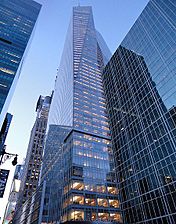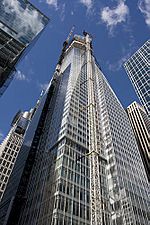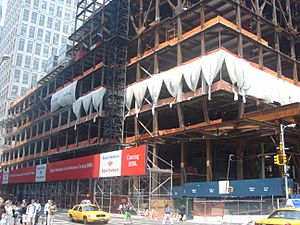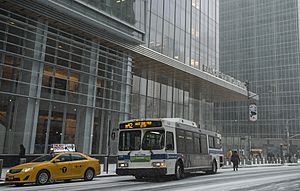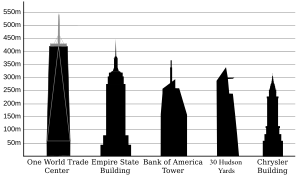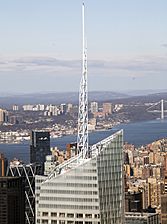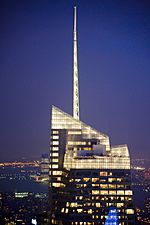Bank of America Tower (Manhattan) facts for kids
Quick facts for kids Bank of America Tower |
|
|---|---|
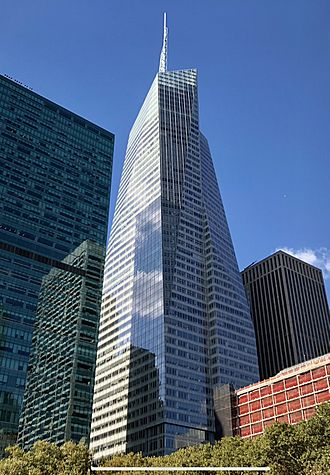
The tower from Bryant Park in October 2020
|
|
| Alternative names | One Bryant Park |
| General information | |
| Type | Commercial offices |
| Location | Sixth Avenue & 42nd Street Manhattan, New York 10036 |
| Coordinates | 40°45′19″N 73°59′03″W / 40.755278°N 73.984167°W |
| Construction started | August 2, 2004 |
| Completed | 2009 |
| Cost | US$1 billion |
| Height | |
| Architectural | 1,200 ft (370 m) |
| Roof | 945 ft (288 m) |
| Top floor | 769 ft (234 m) |
| Technical details | |
| Floor count | 55 (7 mechanical) +3 basement floors |
| Floor area | 2,100,000 sq ft (195,096 m2) |
| Lifts/elevators | 52 |
| Design and construction | |
| Architect | Cookfox Adamson Associates |
| Developer | Durst Organization |
| Structural engineer | Severud Associates |
| Main contractor | Tishman Construction Corporation |
The Bank of America Tower, also known as 1 Bryant Park, is a 55-story skyscraper in the Midtown Manhattan neighborhood of New York City. It is located at 1111 Avenue of the Americas (Sixth Avenue) between 42nd and 43rd Streets, diagonally opposite Bryant Park. The building was designed by Cookfox and Adamson Associates, and it was developed by the Durst Organization for Bank of America. With a height of 1,200 feet (370 m), the Bank of America Tower is the eighth tallest building in New York City and the tenth tallest building in the United States as of 2021[update].
The Bank of America Tower has 2.1 million square feet (200,000 m2) of office space, much of which is occupied by Bank of America. The building consists of a seven-story base that occupies the entire plot, above which rises the tower. Its facade is largely composed of a curtain wall made of insulated glass panels. The building's base incorporates the Stephen Sondheim Theatre, a New York City designated landmark, as well as several retail spaces and a pedestrian atrium. The Bank of America Tower received a Leadership in Energy and Environmental Design (LEED) Platinum green building certification upon its opening. However, because of its high energy use, the building has scored a "C" on a citywide energy-efficiency ranking system.
Seymour Durst had acquired land on the site starting in the 1960s, with plans to develop a large building there, though he was unable to do so because of the presence of other property owners. His son Douglas Durst proposed a large office skyscraper at the beginning of the 21st century and continued to acquire land through 2003. After Bank of America was signed as an anchor tenant, work on the building started in 2004. Despite several incidents during construction, the building was completed in 2009 at a cost of $1 billion. In addition to Bank of America, the tower's tenants have included Marathon Asset Management, Akin Gump Strauss Hauer & Feld, and Roundabout Theatre Company.
Contents
Details
The tower's architectural spire is 255.5 ft (77.9 m) tall and was placed on December 15, 2007. The building is 55 stories high and contains 2,100,000 square feet (195,096 m2) of office space, three escalators and a total of 52 elevators manufactured by Schindler Group – 50 to serve the offices and two leading to the New York City Subway's mezzanine below ground, for the 42nd Street – Bryant Park / Fifth Avenue station.
Several buildings were demolished to make way for the tower. Among them was the Hotel Diplomat, a 13-story structure which occupied the site at 108 West 43rd Street since 1911, and Henry Miller's Theatre, which was rebuilt and reopened at its previous location. The building's tenants include Bank of America as the anchor tenant and Marathon Asset Management, and the tower's platinum LEED rating and modern column-free office space has enticed tenants from all over the city. The Bank of America Tower is considered a worldwide model for green architecture in skyscrapers.
Environmental features
The design of the building makes it environmentally friendly, using technologies such as floor-to-ceiling insulated glazing to contain heat and maximize natural light, and an automatic daylight dimming system. The tower also features a greywater system, which captures rainwater for reuse. Bank of America states that the building is made largely of recycled and recyclable materials. Air entering the building is filtered, as is common, but the air exhausted is cleaned as well. Bank of America Tower is the first skyscraper designed to attain a Platinum LEED Certification.
The Bank of America Tower is constructed using a concrete manufactured with slag, a byproduct of blast furnaces. The mixture used in the tower concrete is 55% cement and 45% slag. The use of slag cement reduces damage to the environment by decreasing the amount of cement needed for the building, which in turn lowers the amount of carbon dioxide greenhouse gas produced through the normal cement manufacturing process. Each ton of regular cement produced creates about one ton of carbon dioxide in the atmosphere.
Temperature control and the production of some of its energy are accomplished in an environmentally friendly manner for the tower. Insulated glazing reduces thermal loss, lowering energy consumption and increasing transparency. Carbon dioxide sensors signal increased fresh air ventilation when elevated levels of carbon dioxide are detected in the building. Conditioned air for the occupants is provided by multiple air column units located in the tenant space that deliver 50 °F air into a raised access floor plenum. This underfloor air system provides users with the ability to control their own space temperature as well as improving the ventilation effectiveness. When building churn occurs, workstation moves can be performed more easily with lower cost and less product waste. The cooling system produces and stores ice during off-peak hours, and allows the ice to melt to help cool the building during peak load, similar to the ice batteries in the 1995 Hotel New Otani Tokyo in Japan. Ice batteries have been used since absorption chillers first made ice commercially available 150 years ago, before the invention of the electric light bulb.
Water conservation features in the tower include waterless urinals, which are estimated to save 8,000,000 US gal (30,000,000 L) of water per year and reduce CO2 emissions by 144,000 lb (65,000 kg) per year (as calculated with the Pacific Institute water-to-air model). The tower has a 4.6-megawatt cogeneration plant, which provides part of the base-load energy requirements.
The magazine Time found out in August 2013 that the Bank of America Tower used twice as much energy overall as the Empire State Building did, due to the large energy usage in the Bank of America Tower and the comparatively small occupancy rate of the Empire State Building.
In summer 2013, the Durst Organization employed Brooklyn Grange Rooftop Farm to install and maintain two honeybee hives on the building.
Height
| Building Name |
Architectural Height |
Roof Height |
|---|---|---|
| One World Trade Center | 1,776 ft (541 m) | 1,368 ft (417 m) |
| 432 Park Avenue | 1,396 ft (426 m) | 1,396 ft (426 m) |
| Empire State Building | 1,472 ft (449 m) | 1,250 ft (380 m) |
| Bank of America Tower | 1,200 ft (370 m) | 953.5 ft (290.6 m) |
| Chrysler Building | 1,046 ft (319 m) | 925 ft (282 m) |
| New York Times Building | 1,046 ft (319 m) | 748 ft (228 m) |
When comparing building height, only the structural height is used according to rules and regulations of the World Council on Tall Buildings. Currently, the New York Times Building and the Chrysler Building are tied for the position of the third tallest buildings in New York City. With the architectural spire included, the structural height of the Bank of America Tower is 1,200 ft (370 m), making it the fourth tallest building in New York City (after One World Trade Center, 432 Park Avenue, and the Empire State Building).
A formal ruling by the Council on Tall Buildings and Urban Habitat has been released, confirming this.
Recognition
In June 2008, the New York Academy of Sciences launched a podcast that highlights these green features.
In October 2009, the building was featured on episode 100 of the National Geographic Channel television series MegaStructures.
In June 2010, the Bank of America Tower was the recipient of the 2010 Best Tall Building Americas award by the Council on Tall Buildings and Urban Habitat.
Construction incidents
Materials fell from the building on three occasions:
- October 17, 2007: A construction container fell from a crane around 1 p.m., causing damage to the tower and injuring eight people on the sidewalk. The container broke windows on several floors of the building, spraying debris that rained down on the streets below. Eight people suffered cuts and bruises. The Buildings Department temporarily stopped construction at the site.
- August 12, 2008: A 1,500-pound (680 kg) glass panel fell onto a sidewalk. Two people suffered minor injuries.
- September 17, 2008: A debris container fell, shattered a panel of glass facade, and caused several pieces of glass to fall from the 50th floor to the sidewalk and street (West 42nd and Avenue of the Americas) at around 3:00 pm (EDT). No one was injured.
Images for kids
See also
 In Spanish: Bank of America Tower para niños
In Spanish: Bank of America Tower para niños


